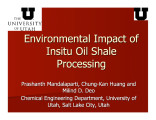TO
Filters: Research Institute: "Institute for Clean and Secure Energy (ICSE)" Collection: "ir_eua" Format: "application/pdf"
| Title | Date | Subject | Description | ||
|---|---|---|---|---|---|
| 201 |
 |
Digital library and interactive map projects at the Institute for Clean and Secure Energy, University of Utah | 2009-10-23 | ICSE; digital repository | The Instituteʼs repository is a not-for-profit service for researchers, and we are working to include a variety of documents, data, and maps relevant to unconventional fuels research and development. |
| 202 |
 |
Gasification studies - Task 4 topical report, Utah Clean Coal Program, Reporting period October 2009 - July 2011 | 2011-10 | Gasification; pressurized entrained-flow coal gasifiers; coal | A key objective of the Task 4 activities has been to develop simulation tools to support development, troubleshooting and optimization of pressurized entrained-flow coal gasifiers. The overall gasifier models (Subtask 4.1) combine submodels for fluid flow (Subtask 4.2) and heat transfer (Subtask 4.3... |
| 203 |
 |
Clean and secure energy from domestic oil shale and oil sands resources: Quarterly progress report: April 2011 to June 2011 | 2011-07-01 | ICSE; Oil shale; Oil sands; University of Utah; Uinta Basin; Vernal, Utah; CLEARuff model; Oxy-gas burner; Bitumen; Kerogen; X-ray fluorescence analysis; Thermogravimetric analysis; CHNS analysis; Lattice Boltzmann model; American Shale Oil; AMSO | The Clean and Secure Energy from Domestic Oil Shale and Oil Sands Resources program is part of the research agenda of the Institute for Clean and Secure Energy (ICSE) at the University of Utah. In this quarter, the Clean and Secure Energy program sponsored the University of Utah Unconventional Fuels... |
| 204 |
 |
Clean and secure energy from Utah's oil shale and oil sands resources: Environmental, legal and policy framework | 2010-04-28 | ICSE; Land use; Water availability; Produced water; Utah; Colorado; Colorado River | This poster addresses major challenges to land use, water availability, and produced water. |
| 205 |
 |
Land and resource management issues relevant to deploying in-situ thermal technologies: Topical Report: October 1, 2009 to December 31, 2010 | 2011-01 | in-situ; oil shale; domestic energy source; oil sands | Utah is home to oil shale resources containing roughly 1.3 trillion barrels of oil equivalent and our nation's richest oil sands resources. If economically feasible and environmentally responsible means of tapping these resources can be developed, these resources could provide a safe and stable dome... |
| 206 |
 |
Method of recovering viscous petroleum from tar sand | 1976-11-30 | Patent; Viscous petroleum recovery; Tar sands | Recovery of viscous petroleum such as from tar sands is assisted using a substantially vertical passage from the earth's surface which penetrates the tar sand and has extending therefrom a lateral hole containing a flow path isolated from the tar sand for circulating a hot fluid to and from the vert... |
| 207 |
 |
Ignition in 40kw co-axial turbulent diffusion oxy-coal jet flames | 2010-08-08 | 40kw co-axial turbulent diffusion; diffusion; oxy-coal; oxy-coal jet flames; partial pressure of O2; coal transport | Outline: 1) Introduction 2) Objectives 3) Experimental setup 4) Methodology to quantify flame stability 5) Results and discussion 6) Conclusions 7) Acknowledgements. The objective of this presentation is to better understand, the effects of partial pressure of O2 in a) the coal transport jet, and b)... |
| 208 |
 |
Assessment of research needs for oil recovery from heavy-oil sources and tar sands | 1982-03 | The Fossil Energy Research Working Group (FERWG), at the request of J. W. Mares (Assistant Secretary for Fossil Energy) and A. W. Trivelpiece (Director, Office of Energy Research), has reviewed and evaluated the U.S. programs on oil recovery from heavy oil sources and tar sands. These studies were p... | |
| 209 |
 |
Clean and secure energy from domestic oil shale and oil sands resources: Quarterly progress report: January 2012 to March 2012 | 2012-04 | ICSE; University of Utah; Green River Basin; CO2 capture; Oil sands; Crude oil refining; International Flame Research Foundation; IFRF; Oil shale; Pyrolysis; Thermogravimetric analysis; TGA; TEA-C burner; Uinta Basin; Flameless oxy-gas process heaters; Efficient CO2 capture; Liquid Fuel Production ... | The Clean and Secure Energy from Domestic Oil Shale and Oil Sands Resources program is part of the research agenda of the Institute for Clean and Secure Energy (ICSE) at the University of Utah. In outreach efforts, ICSE participated in a session on oil sands at the Utah Governor's Annual Energy Deve... |
| 210 |
 |
Clean and secure energy from coal - Phase 3 statement of project objectives | 2011-07-01 | ICSE; University of Utah; CO2 capture; Oxy-coal combustion; Domestic coal resources; Stationary power generation; Clean coal utilization; Chemical looping combustion; CLC; High-pressure entrained-flow coal gasification; IGCC; SNG; NGCC; CNG | The University of Utah (the Recipient), via their Institute for Clean and Secure Energy (ICSE), shall pursue research to utilize the vast energy stored in our domestic coal resources and to do so in a manner that will capture CO2 from combustion from stationary power generation. The research is orga... |
| 211 |
 |
Investigation of coal char-slag transition during oxidation: Effect of temperature and residual carbon | 2009 | coal char; molten slag; bitumous coal; energy and fuels | The transition of coal char to molten slag at high conversion was studied for a bituminous coal using a laminar entrained-flow reactor under oxidizing conditions. Post-oxidized char particles were analyzed by various techniques including loss-on-ignition, gas adsorption analysis and scanning electro... |
| 212 |
 |
Core sample library catalog | 2004-07-15 | Core samples; Geology | |
| 213 |
 |
Method of recovering viscous petroleum from thick tar sand | 1977-02-22 | Patent; Viscous petroleum recovery; Thick tar sand | Recovery of viscous petroleum such as from thick tar sands is assisted using a closed-loop flow path formed in a well by concentric casing and tubular members extending from the earth's surface through a substantial portion of the formation for conducting hot fluid to reduce the viscosity of the pet... |
| 214 |
 |
Method of recovery of bitumen from tar sand formations | 1977-01-18 | Patent; Bitumen recovery; Tar sand formation | A competent permeable communication zone connecting injection and production wells completed in a tar sand which communication zone will be rigid and will not tend to slump or heal may be developed by injecting a fluid in the injection well under such pressure so as to fracture the tar sand formatio... |
| 215 |
 |
Introduction to Enefit | 2011-05-17 | Enefit; oil shale; mining; power generation; oil shale production | Contents 1.Enefit Overview 2.Enefit280 Process 3.Enefit Outotec Technology JV 4.Enefit Activities in Estonia 5.Enefit American Oil |
| 216 |
 |
Mathematical modeling of modified in situ and aboveground oil shale retorting | 1981-01 | mathematical modeling; modified in situ; aboveground oil shale retorting; oil shale | A one-dimensional mathematical model has been developed for simulating the chemicophysical processes involved in the vertical retorting of a rubblized bed of oil shale. Included in the present model are those processes believed to have the most important effects in either the hot-gas retorting mode ... |
| 217 |
 |
Hot water processing of U.S. tar sands -- Water recycle and tailings disposal | 1984 | hot water processing; U.S. tar sands; water recycle; tailings disposal; bitumen recovery | Tailings disposal and water recycle are vital factors for the industrial development of a hot water process for the recovery of bitumen from U.S. tar sands. Based on batch laboratory experiments, with 4 to 12 kg tar sand charge, tailings sedimentation behaviours are presented and discussed for tar s... |
| 218 |
 |
General model of oil shale pyrolysis | 1983-11 | oil shale; oil shale pyrolysis; oil shale pyrolysis model; general kinetic model; kerogen pyrolysis; liquid oil vaporization; liquid oil | Our general chemical kinetic model for oil shale pyrolysis has been further developed. The reactions included in the model are primary pyrolysis of kerogen, vaporization of liquid oil, coking of liquid oil, hydrogenation of liquid oil, cracking of liquid oil, cracking of oil vapor, secondary and ter... |
| 219 |
 |
Median residence and dispersion times for fluidization of crushed oil shale | 1983-03-24 | median residence and dispersion; fluidization of crushed oil shale; crushed oil shale | Median residence times and dispersions for crushed oil shale flowing downward through a fluidized bed were measured as a function of particle size, nominal residence time, and fluidizing gas velocity. For fluidized beds containing narrow particle-size distribution, it was found that median residence... |
| 220 |
 |
Mechanism of low-temperature water evolution from Green River Formation oil shale | 1989-04 | low-temperature water evolution; Green River Formation; oil shale; Mahogany Zone | The water evolved from Green River Formation oil shale (Mahogany Zone) at temperatures between 150 and 400°C as heated at the rate of 4°C/min results from analcime dehydration, and its rate of evolution is affected by the kinetics of dehydration, the transport of water inside and outside oil shale... |
| 221 |
 |
Lands with wilderness characteristics, Resource Management Plan constraints, and land exchanges: Cross-jurisdictional management and impacts on unconventional fuel development in Utah's Uinta Basin | 2012-03 | Utah oil shale; oil sands; unconventional fuel resources; land exchanges; land rights | Utah is rich in oil shale and oil sands resources. Chief among the challenges facing prospective unconventional fuel developers is the ability to access these resources. Access is heavily dependent upon land ownership and applicable management requirements. Understanding constraints on resource acce... |
| 222 |
 |
Methods of tar sand bitumen recovery | 1992-09-01 | Bitumen recovery; Tar sand; Water displacement extraction; Patent | Methods for the recovery of bitumen from tar sands comprising the steps of mixing tar sand, solvent and a displacing amount of aqueous medium to form a mixture, followed by separating a bitumen-rich solvent phase from the mixture and recovering bitumen from the bitumen-rich solvent phase are disclos... |
| 223 |
 |
Method of reducing moisture and solid content of bitumen extracted from tar sand minerals | 2000-02-01 | Tar sand; Alkoxyalkylphenol alkoxylate surfactant; Recoverable hydrocarbon; Anionic and cationic flocculant; Bitumen; Moisture reduction | Tar sand is upgraded to produce a hydrocarbon having a low concentration of water and solids by contacting a bitumen/diluent mix with an alkoxyalkylphenol alkoxylate surfactant prior to separation of a recoverable hydrocarbon phase. The separation of the bitumen/diluent mix into a recoverable hydroc... |
| 224 |
 |
Environmental impact of in-situ oil shale processing | 2007-10 | in situ processing of oil shale; in situ processing; oil shale; production of oil from kerogen; oil production | The in situ processing of oil shale for the production of oil from the kerogen involves heating the shale slowly to moderate temperatures of between 3000 C and 4000 C. At this temperature, gaseous products that evolve from the oil shale are condensed and recovered. The pathways of creation of oil fr... |
| 225 |
 |
Fischer Assay Data, Utah Geological Survey Well Number U313 | 2008 | This dataset contains the results of Fischer assay analyses obtained and published by the Utah Geological Survey for well U313. |
